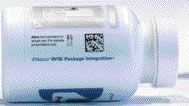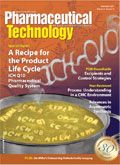Printing Digital Labels
Going digital can produce high-quality, full-color labels at potentially lower cost.
Although digital printing technology has existed for at least a couple decades, the use of narrow-web digital presses to print labels for pharmaceutical products is a more recent development.
Advantages and innovations
Conventional printing processes such as flexographic, offset, or rotogravure require a prepress workflow involving preparation of a medium or series of media—one for each color—to create the image that is reproduced on the label material. Digital printing eliminates the need for the film, plates, and cylinders used by conventional presses because the image resides in the computer and outputs directly onto the label film or paper using special inks. Resulting labels are typically finished with a topcoat to enhance gloss and protect the printed surface from damages such as abrasions.

Hallie Forcinio
Moving the prepress process into the computer can save hundreds of dollars per stock-keeping unit (SKU) per run and shortens lead time to an average of one to two weeks versus three to four weeks for standard flexographically printed labels. Although the typical lead time for digitally printed labels is fewer than 10 days, overnight or even same-day delivery is possible.
In addition, the deletion of so many of the steps in the process helps eliminate areas for potential quality-related issues. Many pharma manufacturers see digital printing as a way to improve the overall quality of printed packaging.
Shorter lead time makes it possible to deliver labels on-demand and reduce label inventories and storage requirements. It also minimizes, if not totally eliminates, label obsolescence and waste. The shorter turnaround allows drug makers to react more quickly to changes in regulations or market conditions, enabling faster launches into new markets and customization to address the needs of specific patient populations, track-and-trace requirements or counterfeit prevention.

Digitally printed labels can incorporate serialized 2D barcodes and RFID inlays to address track-and-trace and pedigree requirements.
Computer control also ensures high-quality reproduction equivalent to offset printing with precise registration, scannable bar codes, and consistent color label-to-label and run-to-run. In fact, color consistency and registration are improved significantly when compared to conventional print methods. Because the computer-based process relies on electronic data, variable information such as serialized coding is easily included, making the technology ideal for meeting track-and-trace and pedigree requirements.
Digital printing also is compatible with radio frequency identification (RFID) as well as a wide range of security features such as microprinting, color-shifting ink, taggants, watermarks, and two-dimensional barcodes.
Because changeover from printing one label design to printing another is primarily computer-based, it requires minimal cleaning and reconfiguring of the press and generates very little waste, typically not more than 20 ft. of label material. As a result, downtime related to changeover is almost nonexistent, making the computer-to-label digital printing process well suited to the extremely short runs typically required for promotions or prelaunch samples. However, longer runs, up to about 200,000 labels, often are cost effective.
"Depending on label size, the economic target would be runs of 1000 to 200,000," says Joe Tenhagen, vice-president of marketing at Nosco (Gurnee, IL), a printer that specializes in producing labels and other packaging for the pharmaceutical industry. "With this new business solution, production planners can rethink how they order, receive, and manage their brands," he adds.
A mathematical formula—label width × label length × quantity—can help determine whether digital printing is practical for a particular label. Generally, if the answer is between 400 and 600, the job is a good candidate for digital printing, according to Nosco's website. Thus, digitally printed labels are being specified for a growing number of pharmaceutical, biotech, and animal-health products and medical devices where the majority of SKUs fall within this volume range.
Transitions to digital printing
The transition to digital printing impacts production planning, supply-chain management, inventory, and purchasing. For pressure-sensitive labels, the label material may not need to change. However, printing specifications may need to be revised to permit the digital process. Quality control procedures will probably change, especially if the label printer assumes more responsibility.
At a major pharmaceutical products company, which ordered its first digitally printed labels in 2004, a certified printing process eliminates the need for incoming quality inspection, so labels can be delivered directly to the packaging line (Nosco On Demand Solutions, Nosco). With labels delivered on a just-in-time schedule, and all labels now converted to digital production, the manufacturer has been able to convert its label storage room to other uses.
Digital tools
One narrow-web digital press especially designed for label printing has four color stations, but can be extended to seven, which adds orange, violet, and possibly green to the standard four-color process (cyan, magenta, yellow, and black) to enable reproduction of a wide range of spot colors. Although combinations of these six or seven colors permit duplication of virtually any Pantone shade specified for a conventional press, special matched colors also are available. In fact, ink cartridges can be removed and replaced while the press is in operation so spot colors can be changed without causing downtime.
High-quality reproduction relies on a print engine with a resolution of 800 dots per inch and a range of screen options, including 144, 160, 175, 180, and 230 lines per inch ("HP Indigo press ws4500" digital printing press, (Hewlett-Packard Co. (HP)), Atlanta, GA). Computer control delivers crisp graphics, ensures tight registration and eliminates the need for trapping, or overlapping, colors to ensure full ink coverage. It's also possible to clearly print type in very small point sizes.
Although the majority of digital presses seem to be designed for document reproduction or book publishing, at least two other companies build digital printing systems capable of printing labels ("Kodak Versamark" high-volume inkjet systems, Eastman Kodak Co., Rochester, NY; "Cromaprint" digital printing systems, Dupont Packaging, Wilmington, DE).
There also are a few digital systems designed to print on corrugated board for applications such as short run transport packaging, point-of-purchase displays and samples ("HP Scitex FB6700" digital printing system, HP).
Although currently concentrated on labels, digital technology is expected to move into cartons and other packaging formats. "If you can wrap the material around a cylinder, we can print on it," explains Retha Petruzates, marketing manager for HP Indigo Digital Printing Solutions.
Validation
A growing number of label converters operate validated digital printing systems. Pharmaceutical label printers follow a validation process similar to pharmaceutical manufacturers and comply with applicable US Food and Drug Administration and European Union rules such as 21 CFR 211.68 equipment (controls and backup), 21 CFR 211.122 labeling controls (cut labeling and controls), 21 CFR 211.180 records (available for inspection), 21 CFR 820.70 automated processes (validated software), 21 CFR 821.120 device labeling (label integrity), 21 CFR 11 electronic records, and EU GMP 5.33 label quality.
Printing press suppliers typically assist with the validation process. For example, one press supplier supports and expedites validation efforts by providing reports related to risk analysis, validation plan, installation qualification, operational qualification, performance qualification, and validation process summary (HP validation pack, HP).
Pharmaceutical label printers have policies and procedures in place to streamline workflow and prevent and detect errors. In addition to stringent quality control, the inspection process is rigorous, in some cases using a combination of manual and automated methods to achieve a level of 200% inspection. Pharmaceutical label printers also take great care to secure computer files, proofs, label material, printed labels and waste.
Pedigree requirements
As the January 1, 2009 deadline approaches for compliance with California's pedigree law, which requires drugs shipped to distributors to carry a unique identifier at the item level to support an electronic track-and-trace record keeping system, some wholesalers and drugmakers view RFID tagging at the item and case level as the ideal data carrier because information can be captured from the tags without the reader being in the line of sight of the packages. For drugmakers that don't have the RFID infrastructure in place, particularly for tagging at the item level, digitally printed two-dimensional (2D) barcodes can provide the unique identifier.
Options include printing a serialized 2D barcode or electronic product code number on the item label or on a medallion label that is applied separately to the item. Information about the item codes is then captured and written to an RFID case tag to link parent/child information. If RFID case tagging is not available, the item-level information can be captured and incorporated into a 2D code that is digitally printed on the case label so information about the contents of the case travels with it.
Several companies are working together to provide the hardware and software necessary for a pedigree process based on 2D barcodes.
Hallie Forcinio is Pharmaceutical Technology's Packaging Forum editor, 4708 Morningside Drive, Cleveland, OH 44109, tel. 216.351.5824, fax 216.351.5684, editorhal@cs.com.
